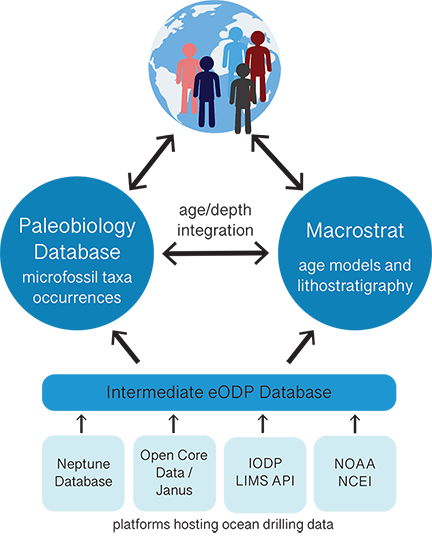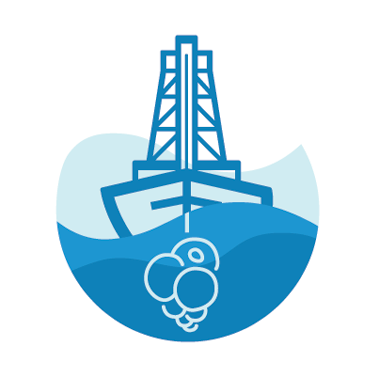About the eODP Project
The Extending Ocean Drilling Pursuits [eODP] project is bringing together sedimentary description and microfossil data from ocean cores into one, searchable platform. Scientific ocean drilling has revolutionized earth science for over 50 years. The data gathered on research vessels are stored in segregated databases that, while open access, are difficult to use.
eODP is harnessing the computational power and infrastructure of existing, relational databases to make these data easily accessible and searchable and to enable scientists to undertake large-scale research projects in an efficient and effective manner.
The eODP project is amassing ocean drilling data from several sources into one database structure and standardizing all of the columns and fields across decades of file formats. These data will be integrated into the Paleobiology Database and Macrostrat for permanent hosting. The two databases are connected through an API, allowing the flow of lithologic, paleontologic, age, and depth data between the two platforms. The end user will have the ability to search the eODP datasets through a dynamic front-end interface.

eODP is funded through NSF’s EarthCube program from September 2019 to 2022.
Microfossil Census Counts and Taxonomy
Several microfossil groups have been documented in core sediments, the most common being calcareous nannofossils, diatoms, radiolarians, and planktic and benthic foraminifera. Pollen, dinoflagellates, and silicoflagellates are also prevalent. Quantitative and qualitative abundance, group preservation, and biostratigraphy are being added to the Paleobiology Database (PBDB). With the completion of this project, eODP will roughly double the fossil occurrences within the PBDB.
Taxonomy and taxonomic names have greatly changed over the past 50 years. eODP is utilizing the flexible taxonomy structure of the PBDB, which allows for the linkage of accepted names to junior synonyms.
Stratigraphic Sections
Sedimentary lithology for all ocean drilling holes is being included in Macrostrat. This includes all primary and subordinate lithologies and sedimentary features. Macrostrat hosts terrestrial and oceanic geologic descriptions from all over the globe. The API for Macrostrat enables a connection to the outreach platforms Rockd (mobile app), Mancos (iOS), and Flyover Country (mobile app).
Age Models
Age of the sediments and fossils is invaluable data information, allowing correlation of sections, identification of critical time intervals, and performing basic database queries. Shipboard generated ages will be imported to Macrostrat, which has the capability of automatically constructing age modes. Users will be able to add updated, published age models for each section to improve the accuracy of the assigned age.
The PBDB will access age information from Macrostrat through the existing API connection. Age/depth integration will occur across the two platforms.
Accessibility and Visualization
eODP will have a single portal for accessing all data, with a user-friendly web interface. Both the PBDB and Macrostrat have visualization tools that allow the user to observe
user-friend front end for searching databases in one location.
Visualization tools are available through the PBDB and Macrostrat websites.
Outreach
eODP is partnering with Flyover Country (mobile app) to make the ocean drilling data discoverable and accessible to the public. Flyover Country will display ocean drilling localities, fossils, and eODP specific curated content about significant localities.


